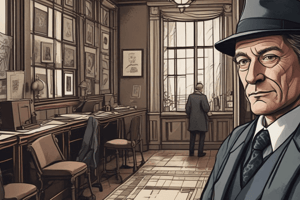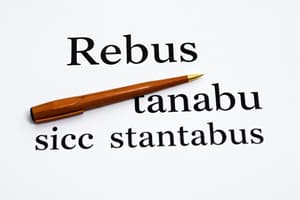Podcast
Questions and Answers
What does a rebus quiz primarily use to represent words or phrases?
What does a rebus quiz primarily use to represent words or phrases?
- Audio and sound effects
- Numbers and calculations
- Text and explanations
- Pictures, symbols, or letters (correct)
Which element is NOT typically used in creating a rebus?
Which element is NOT typically used in creating a rebus?
- Pictures that represent words
- Symbols with specific meanings
- Complex equations (correct)
- Individual letters for phrases
What is the first step in creating a rebus quiz?
What is the first step in creating a rebus quiz?
- Choose a theme (correct)
- Test for clarity
- Provide instructions
- Select phrases or words
Why is it important to balance difficulty in a rebus quiz?
Why is it important to balance difficulty in a rebus quiz?
What type of phrases should be used for a rebus quiz to encourage broader appeal?
What type of phrases should be used for a rebus quiz to encourage broader appeal?
What is an effective tip for adding engagement to a rebus quiz?
What is an effective tip for adding engagement to a rebus quiz?
Which tool is recommended for creating digital rebus quizzes?
Which tool is recommended for creating digital rebus quizzes?
When assembling the rebus, what must be ensured about the visual elements?
When assembling the rebus, what must be ensured about the visual elements?
Flashcards are hidden until you start studying
Study Notes
Creating Rebus Quizzes
-
Definition: A rebus quiz uses pictures, symbols, or letters to represent words or parts of words, creating a visual puzzle that the solver must decipher.
-
Components of a Rebus:
- Pictures: Images that represent words or phrases (e.g., a picture of a bee for "be").
- Symbols: Common symbols that have a specific meaning (e.g., "@" for "at").
- Numbers: Used to represent sounds or parts of words (e.g., the number 4 for "for").
- Letters: Sometimes individual letters are used in creative ways to represent phrases (e.g., "C" for "see").
-
Steps to Create a Rebus Quiz:
- Choose a Theme: Decide on a central theme or topic for the quiz (e.g., movies, idioms, famous quotes).
- Select Phrases or Words: Pick phrases, sayings, or words that relate to the chosen theme.
- Visual Representation:
- Break down each phrase into manageable parts.
- Use pictures, symbols, and letters creatively to depict those parts.
- Assemble the Rebus: Arrange the visual elements in a way that logically represents the phrase.
- Test for Clarity: Ensure that the rebus is challenging yet solvable; ask others to try decoding it.
- Provide Instructions: Clearly state how participants should decode the rebus (e.g., "What phrase does this represent?").
-
Tips for Effective Rebus Quizzes:
- Balance Difficulty: Mix easy and challenging rebuses to engage a wide audience.
- Use Familiar Phrases: Stick to common expressions or well-known references for broader appeal.
- Incorporate Humor: Adding funny or witty visuals can increase engagement and enjoyment.
- Limit Complexity: Avoid overly complicated representations that may frustrate solvers.
-
Tools for Creation:
- Drawing Software: Programs like Canva or Photoshop for digital designs.
- Physical Materials: Paper, markers, and magazines for a DIY approach.
- Online Platforms: Use websites that specialize in quiz creation for a more interactive experience.
-
Engagement and Interaction:
- Encourage participants to explain their thought process for each answer.
- Consider group activities where teams compete to solve rebuses.
-
Potential Uses:
- Educational exercises in language or visual literacy.
- Icebreakers at events or parties.
- Fun activities in team-building workshops.
Definition of Rebus Quizzes
- Rebus quizzes utilize pictures, symbols, or letters to convey words or parts of words, forming a visual puzzle.
Components of a Rebus
- Pictures: Utilize images that represent specific words or phrases, such as a bee for "be."
- Symbols: Incorporate common symbols with recognized meanings, like "@" signifying "at."
- Numbers: Employ numbers to symbolize sounds or parts of words, for instance, using 4 for "for."
- Letters: Use individual letters creatively to represent phrases, such as "C" for "see."
Steps to Create a Rebus Quiz
- Choose a Theme: Select a central theme (e.g., movies, idioms) to guide the quiz.
- Select Phrases or Words: Identify phrases or words related to the chosen theme.
- Visual Representation: Break down selected phrases into manageable elements; creatively depict components with images, symbols, and letters.
- Assemble the Rebus: Arrange visual elements logically to represent the chosen phrase effectively.
- Test for Clarity: Ensure rebuses are challenging but solvable by testing them with others.
- Provide Instructions: Clearly communicate how participants should decode the rebus, like asking them to identify the represented phrase.
Tips for Effective Rebus Quizzes
- Balance Difficulty: Combine easy and difficult rebuses to cater to a broad audience.
- Use Familiar Phrases: Stick with commonly known expressions for wider accessibility.
- Incorporate Humor: Funny visuals can enhance engagement and enjoyment.
- Limit Complexity: Avoid overly intricate representations to prevent frustration among solvers.
Tools for Creation
- Drawing Software: Use programs like Canva or Photoshop for digital rebus designs.
- Physical Materials: Engage in a DIY approach with paper, markers, and magazines.
- Online Platforms: Explore specialized websites for interactive quiz creation.
Engagement and Interaction
- Promote open discussions where participants explain their reasoning for each answer.
- Encourage team-based activities for competitive rebus solving.
Potential Uses
- Serve as educational exercises focusing on language or visual literacy.
- Act as icebreakers at events or social gatherings.
- Provide fun activities in team-building workshops.
Studying That Suits You
Use AI to generate personalized quizzes and flashcards to suit your learning preferences.




